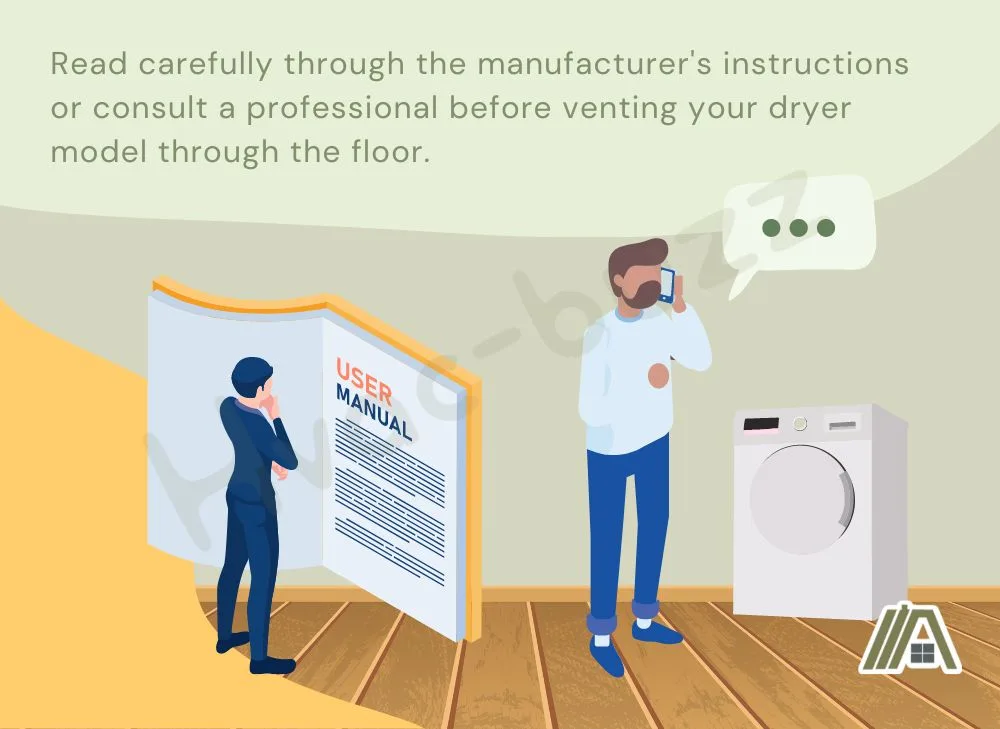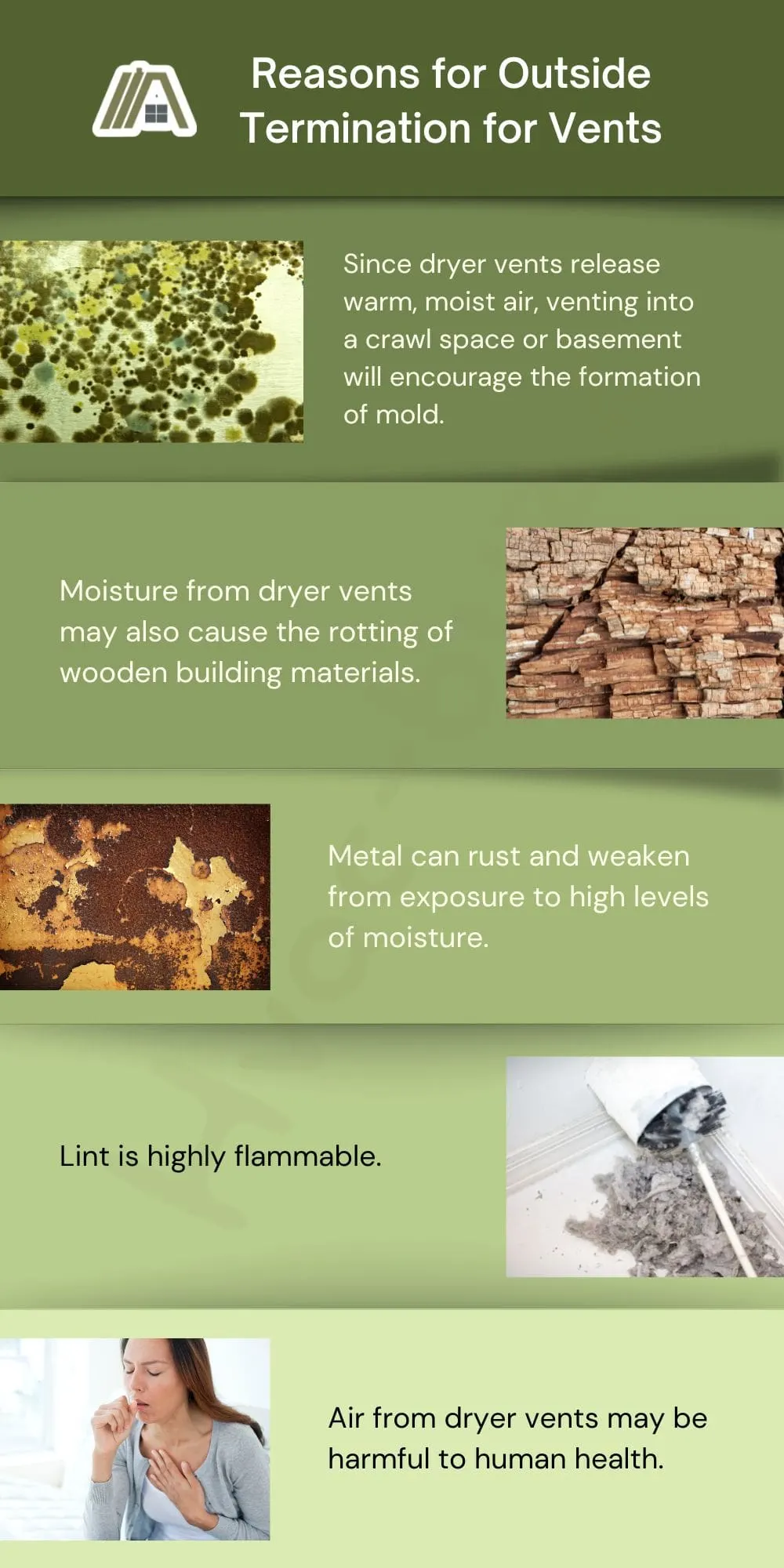When it comes to installing dryers, the ideal location of the machine may mean that running its vents through the floor seems like the most convenient option. A major concern, however, is whether this is allowed and safe according to regulations.
In this article, we provide a summary of the regulations for dryer exhaust systems and outline some things you may want to consider before running vents through the floor.

Dryers can be vented through the floor if doing so does not go against the manufacturer’s instructions. However, it is only possible on upper floors and maybe the ground floor. This venting route is also harder to keep away from openings into the house.
What Does the Manufacturer Say?
According to Section M1502.1 of the International Residential Code (IRC):
“Clothes dryers shall be exhausted in accordance with the manufacturer’s instructions.”
This means that the IRC defer to the authority of the people who make the dryers when it comes to venting.
So, if the manufacturer does not include the floor as a venting route, then the dryer is not compatible with the exhaust system needed to vent it through the floor, and doing so may cause a fire hazard.
Additionally, unsuitable vent systems can shorten the life of the dryer and reduce performance, thereby leading to longer drying times and greater energy consumption.
Hence, it is best to read carefully through the manufacturer’s instructions or consult a professional before venting your dryer model through the floor.

Why Manufacturers Have the Final Say
The reason why the IRC defers to the manufacturer is that different dryers have different capabilities and requirements. To list them all in the IRC would be tedious and pointless as technology progresses and changes.
Instead, the IRC allows the manufacturer to dictate how best to vent the appliance that they made and they maintain control because in order to market and sell their appliance, manufactures must get their products tested against safety standards.
In case the manufacturer does not specify venting conditions or only provides very basic instructions, the IRC does set out some general rules to follow regarding the materials, dimensions, installation, and termination.
Vents Must Terminate Outside
Although dryers can be vented through the floor, they must terminate on the outside of a building according to the manufacturer’s installation instructions.
So, it cannot vent through the floor and then terminate in a crawlspace or the like.
This requirement is according to Section M1502.3 of the IRC.
Reasons for Outside Termination
The requirement for dryer vents to terminate outside stems from several health and safety precautions:
- Since dryer vents release warm, moist air, venting into a crawl space or basement will encourage the formation of mold.
- Moisture from dryer vents may also cause the rotting of wooden building materials, such as the foundations or beams of a crawl space.
- Metal can rust and weaken from exposure to high levels of moisture.
- Lint is highly flammable and although a considerable amount of lint will be caught in the dryer’s lint trap, some lint will always escape through the vent, posing a fire hazard where it is released.
- Air from dryer vents may be harmful to human health because of emissions from laundry products. Even if they are vented below your house, these emissions can enter living spaces through gaps in the floor.

Through the Floor to the Outside
Not Expressly Prohibited
It is not stated in the IRC that dryer vents cannot run through the floor before terminating on the outside.
However, there are some practical considerations and legislation that might make this an option that is more challenging than it is convenient.
Practical Considerations
Where the Vent Leads
Venting through the floor would only be possible when the dryer is above grade. If your laundry is in the basement, you would be digging through the foundations and you’d have to find a path through to the surface.
Even dryers on the ground floor will likely not be able to be vented through the floor.
Dryer exhaust systems should follow the shortest route possible according to the manufacturer’s instructions.
If you wanted to vent a dryer through the ground floor, the pipes might have to lead down before going up again so that the vent terminates outside. This is not likely to be the shortest route.
An exception would be when your ground floor is elevated and there is a way to vent the duct outside after going down and sideways.
Floor venting is achievable if the dryer is located in rooms on upper levels in a house. However, there are still other considerations.
Going Against Natural Movement of Air
Hot air rises, so venting down would be a less effective option, as there may be issues in the removal of hot air from the dryer.
This in turn could cause performance issues, such as increased drying time.
Floors Are Hard
It is often more difficult to make holes in the floor for venting than to make holes in the wall or ceiling, so venting through the floor may not be worth the effort.
Required Distance From Openings Into House
If a termination location is not specified in the owners’ guide, Section M1502.3 of the IRC dictates that exhaust ducts should terminate at least three feet in any direction from openings into buildings, which includes ventilated soffits.
Again, this rule is to prevent the emission of moist air into living spaces, and to prevent lint particles from escaping into indoor areas.
In home fires involving clothes dryers, dust, fiber, or lint were often the first items ignited, so the rules stipulated in the IRC are there to minimize the risk of such fires occurring.
If you are looking to vent a dryer down through the floor, the dryer itself will either be on the ground or upper floors.
By venting down and out instead of up or horizontally, it is more likely that the vent termination will be closer to windows, doors, and even passive soffit vents.
So, the requirements of the IRC may mean that venting through the floor will take careful consideration.
If you’ve heard that the dryer vent can’t be higher than the dryer, then know that this is not the case.
If you’re just struggling to find a good venting route, why not consider going ventless?
Sources
http://pdf.lowes.com/productdocuments/09a31b79-6312-4be4-86ce-a48171703e58/44341624.pdf
https://content.syndigo.com/asset/8703a46c-da97-41b3-911b-8a1ee38767b8/original.pdf.
